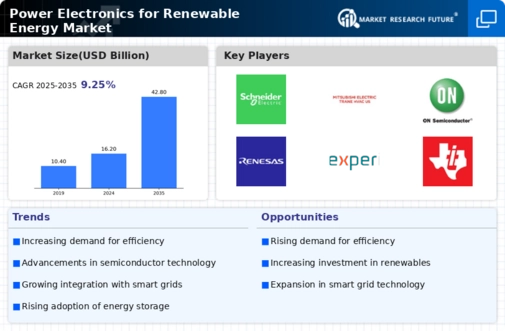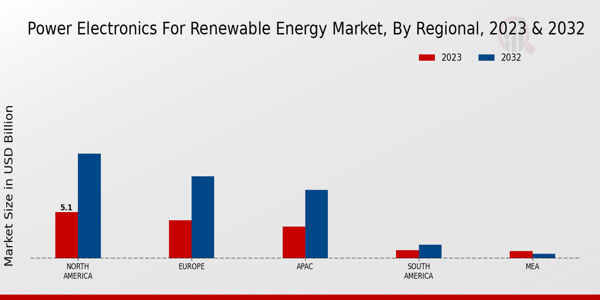Market Growth Projections
The Global Power Electronics for Renewable Energy Market Industry is projected to experience robust growth over the coming years. With a market value of 16.2 USD Billion in 2024, it is anticipated to reach 42.8 USD Billion by 2035. This growth trajectory suggests a compound annual growth rate (CAGR) of 9.25% from 2025 to 2035. Such projections indicate a strong demand for power electronics solutions in renewable energy applications, driven by technological advancements, government policies, and increasing awareness of sustainability. The market's expansion reflects the global transition towards cleaner energy sources.
Government Incentives and Policies
Government incentives and supportive policies significantly influence the Global Power Electronics for Renewable Energy Market Industry. Many nations offer tax credits, subsidies, and grants to promote the adoption of renewable energy technologies. For example, the United States has implemented the Investment Tax Credit (ITC) for solar energy, which has stimulated market growth. Such initiatives not only lower the financial barriers for consumers but also encourage manufacturers to innovate and expand their product offerings. As a result, the industry is expected to grow at a compound annual growth rate (CAGR) of 9.25% from 2025 to 2035, reflecting the positive impact of these policies.
Rising Awareness of Climate Change
The Global Power Electronics for Renewable Energy Market Industry is significantly influenced by the growing awareness of climate change and its impacts. As public consciousness regarding environmental issues increases, there is a stronger push for sustainable energy solutions. This shift in consumer behavior encourages investments in renewable energy technologies, including power electronics. Companies are increasingly adopting green practices, and consumers are demanding cleaner energy options. This trend is likely to accelerate the transition towards renewable energy sources, contributing to the market's expansion and aligning with global efforts to combat climate change.
Growing Demand for Renewable Energy
The Global Power Electronics for Renewable Energy Market Industry experiences a notable surge in demand as countries strive to meet renewable energy targets. Governments worldwide are increasingly investing in solar, wind, and other renewable sources, leading to a projected market value of 16.2 USD Billion in 2024. This growth is driven by policies aimed at reducing carbon emissions and enhancing energy security. For instance, the European Union's Green Deal aims to make Europe climate-neutral by 2050, further propelling the adoption of power electronics in renewable energy applications. As a result, the industry is poised for substantial expansion.
Increasing Energy Efficiency Requirements
The Global Power Electronics for Renewable Energy Market Industry is also driven by the rising demand for energy efficiency. As energy consumption continues to rise globally, there is an increasing emphasis on reducing waste and optimizing energy use. Power electronics play a crucial role in enhancing the efficiency of renewable energy systems, enabling better integration with the grid. For instance, advanced inverters and converters improve the performance of solar and wind installations, ensuring that more energy is harnessed and utilized effectively. This focus on efficiency aligns with global sustainability goals, further propelling market growth.
Technological Advancements in Power Electronics
Technological innovations play a pivotal role in the Global Power Electronics for Renewable Energy Market Industry. Advancements in semiconductor materials, such as silicon carbide and gallium nitride, enhance the efficiency and performance of power electronic devices. These innovations enable better energy conversion and management in renewable systems, which is crucial for maximizing output from solar panels and wind turbines. As these technologies mature, they are expected to drive down costs and improve system reliability. This trend is likely to attract further investments, contributing to the market's anticipated growth to 42.8 USD Billion by 2035.
















